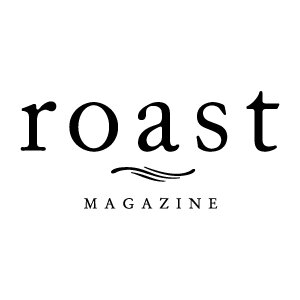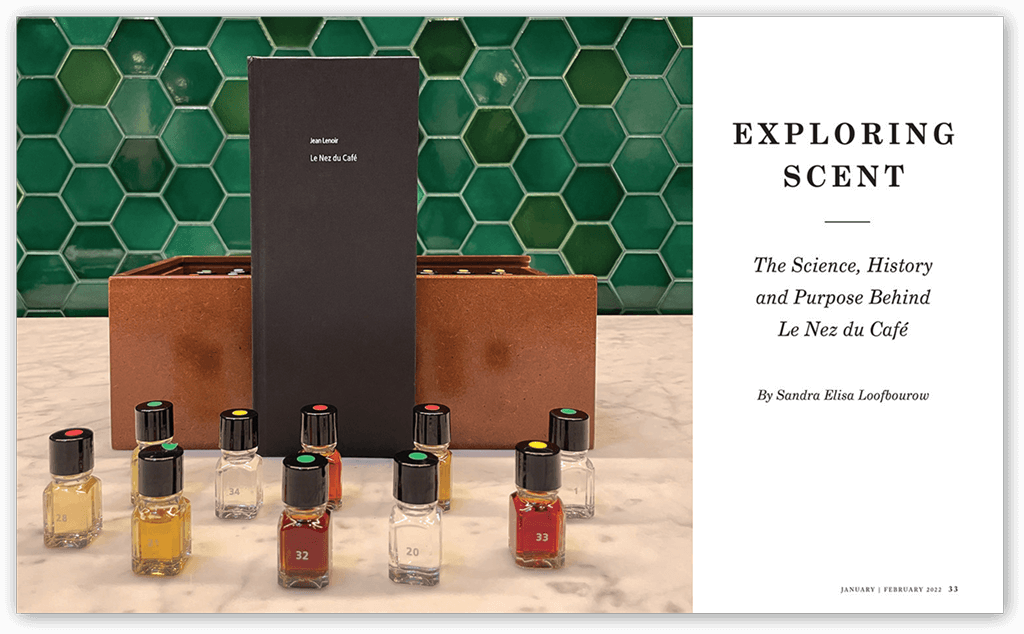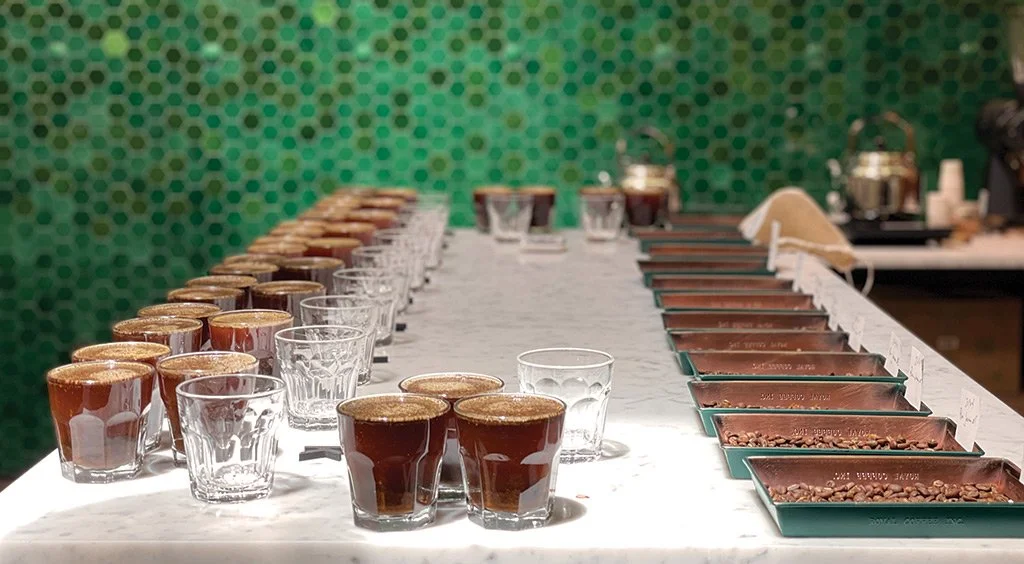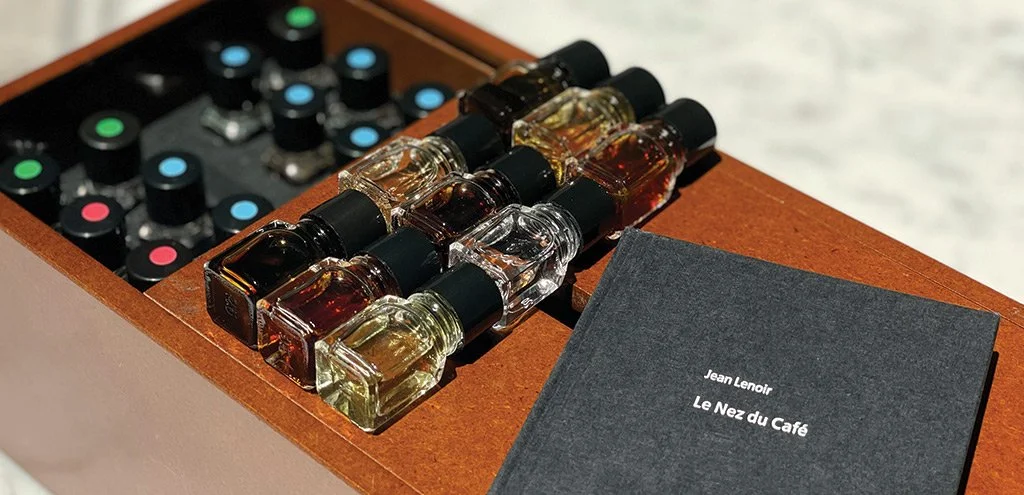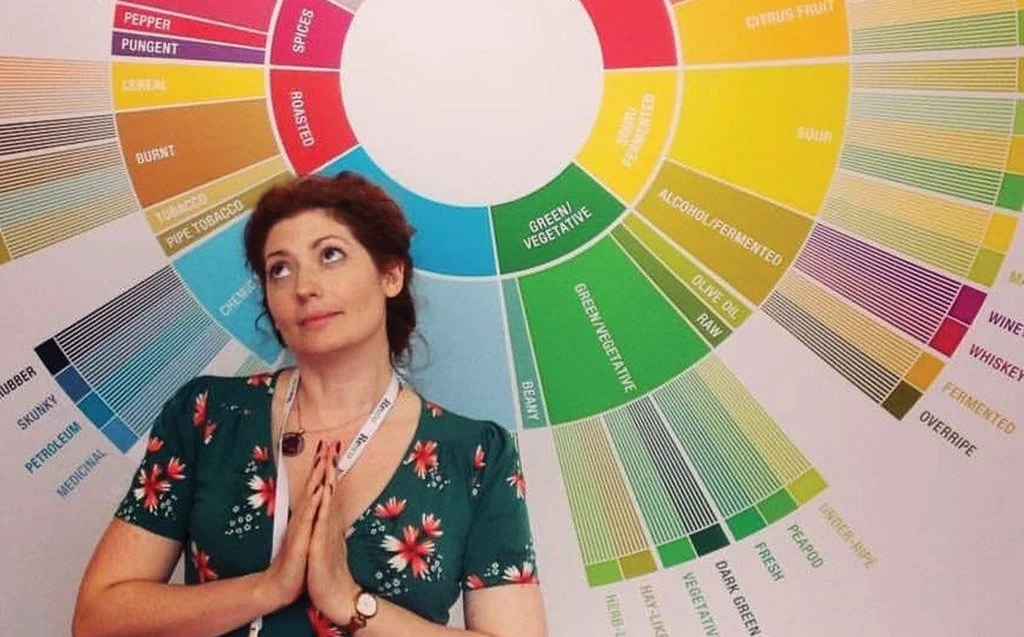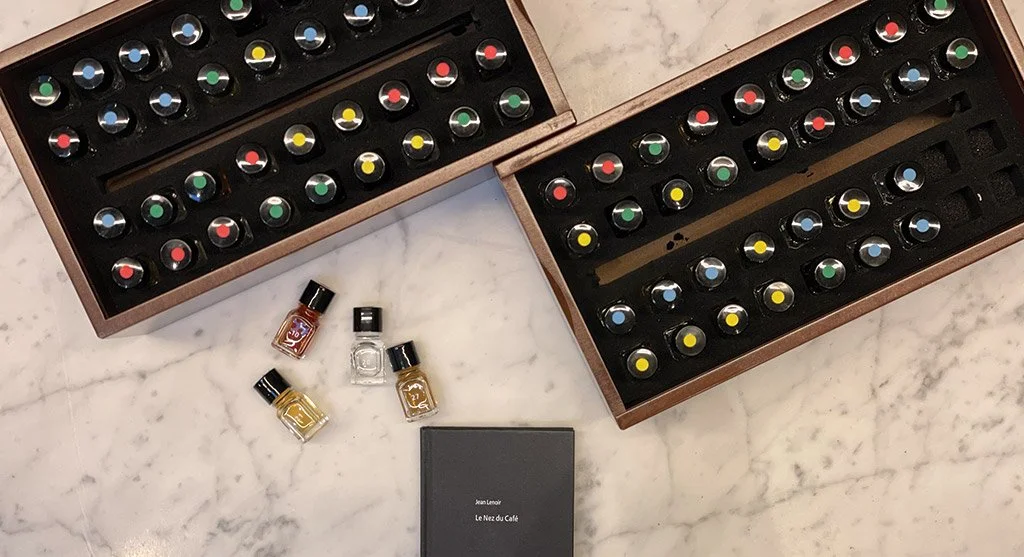Exploring Scent: The Science, History and Purpose Behind Le Nez du Café
By Sandra Elisa Loofbourow
It’s early morning and I’m trying desperately to get my brain and my voice warmed up to record a viable interview. Across the pond in Paris, Viva Lenoir is at the end of her day; her gregariousness is topped off by a hint of fatigue. We meander toward each other through the fog at opposite ends of our workday.
I’m recording Lenoir for an interview for my podcast “Cafetera Intelectual.” She’s been incredibly generous with her time, and I’m trying to make every minute count. With a career as a comedian and a radio commentator under her belt, she easily puts me at ease. “I wanted to make people laugh. That’s the best form of love you can be given,” she says of her work as a comic. “Every comedian will say they have a very profound, very deep need for love.”
Lenoir’s communication style is clear and precise, and always colored by personal history. She is the aromatic department director for Editions Jean Lenoir, a company that makes sets of vials of specific aromas packaged under a variety of names, including Le Nez du Café. These tools, serving the wine, coffee and whisky industries specifically, aid in increasing tasters’ sensory acuity and are essential in improving communication between sensory experts. They can be the bridge between two cuppers’ separate—and extremely personal—sensory perceptions of the world.
Digging into the deeply personal is one of the best ways to hone one’s sense of smell: “The olfactory system is so linked with emotion that it actually becomes relevant to think about personal things,” says Lenoir. “Emotion is the key to accessing your senses.” The more intimate and precise we are about how a certain aroma makes us feel, or what memories it evokes, the more likely we are to retain and correctly identify that same aroma the next time we come in contact with it.
There’s science to back this up. As Harold McGee says in his fascinating book Nose Dive: A Field Guide to the World's Smells, published in 2020, “Sensations and perceptions, smells and tastes and flavors, are products of our brain. The brain doesn’t simply register the direct reports of those receptors, but actively creates smells and tastes and flavors by filling out those reports with many other kinds of available information, and especially information from its database of past experiences.” This also means that we can only talk about new sensory inputs in the context of previous experiences: “What we smell and how we talk about it both depend on the happenstance of our individual lives.”
Since Le Nez du Café’s inception more than 25 years ago, we’ve seen a few other options turn up—most notably the ScentOne kit and World Coffee Research’s Sensory Lexicon. While the Le Nez kits, and tools like them, provide excellent training for personal sensory development, it’s their use as a communication tool between cuppers that makes them such an integral part of sensory development for our industry. By creating common ground and building vocabulary for sensory analysis, they act as a bridge between cuppers who might otherwise never realize they are experiencing the same aromatic molecules. Even more important, they can level the playing field between cuppers at different ends of the supply chain. These kinds of tools are instrumental in forming a global vocabulary of quality.
We owe a debt of gratitude to Jean Lenoir, Viva’s father, who introduced Le Nez du Café in 1996 after working with taste and smell in the wine industry for nearly two decades. When Lenoir first launched Le Nez du Vin in 1981, it was the first olfactory training kit of its kind. Now, after more than 25 years of widespread use in the specialty coffee industry, we take a look at the legacy of Le Nez du Café.
How Do We Sniff Scents?
Scent perception happens when an object’s volatile molecules escape and fly up into one’s nose or mouth. There they travel up to the cilia of the olfactory epithelium, a tiny patch of tissue located inside the nasal cavity just below the eyes. These cilia—strand-like organelles lining the epithelial tissue—have receptors at the free end. The axons of the cilia come together to form olfactory nerves, which in turn bundle together and form the olfactory bulb on the inside of the cranium at the forefront of the brain. Upon receiving input, the axons of the cilia send signals to the olfactory bulb which in turn passes this information along to the central nervous system.
The receptors at the end of the cilia are a specific shape, and certain molecular structures can fit only into certain receptors. The term “lock and key” is often used to describe this system—the molecules must have the right key shape to fit into the receptors at the end of the cilia. These olfactory receptors work together to form many different combinations of smells, so although there are only an estimated 400 receptors, McGee says humans can theoretically distinguish between many millions of different molecules and molecule mixtures. Even the simplest scents are formed from a composite of molecules, and McGee draws the connection between a bouquet of aromatic molecules and a musical chord—many disparate notes played together to create one harmonious sound.
Most molecules are too big or heavy to become “volatile,” or airborne. What we perceive as scents are only a small selection of molecules that escape the surface of the object. Though we casually say that foods have flavors and flowers have smells, in fact what they have are aromatic molecules. Rather than being odiferous themselves, these molecules trigger our ability to smell. “Smells are triggered by mixtures of volatile molecules, then shaped and presented as simplified conscious perceptions by the actively editing synthesizing brain,” says McGee. Gordon M. Shepherd uses an apt metaphor in his book Neurogastronomy: How the Brain Creates Flavor and Why It Matters, published in 2012, noting, “It’s important to realize that flavor does not reside in a flavorful food any more than color resides in a colorful object.” In his words, the brain is actively creating the sensation of flavor based on sensory input primarily stimulated by what’s called retronasal olfaction.
Retronasal smelling can also be called “mouth-smell,” and it happens when vapors go up from the mouth or the back of the throat into the nasal cavity. It contrasts with orthonasal smell, which is what we call sniffing things directly through the nostrils. In fact, retronasal smell completely dominates flavor detection. “We often characterize our food in terms of how it ‘tastes,’ but the sense of taste as properly defined consists of sensitivity only to sweet, salt, sour, bitter and umami,” says Shepherd. “What we call the taste of food beyond these simple sensations should be called flavor and is mostly due to retronasal smell.” He goes so far as to say, “The sense of flavor produced is a mirage; it appears to come from the mouth, where the food is located, but the smell part, of course, arises from the smell pathway.”
Because of the way we perceive aromatic molecules, scents can only be recognized in reference to other aromatic molecules we’ve already encountered. “We can only come up with a description for molecule mixtures that we recognize from experience, or for individual molecules that we recognize as being a prominent part of familiar mixtures,” says McGee. New scents, he adds, may remind us of other aromatic molecules: “When different things seem to echo each other with shared component smells, it’s a sign that those things have some volatile molecules in common. How we register and name and think about smells depends on where we’ve happened to encounter them first.”
History of Le Nez
It may come as a surprise to many coffee professionals that the Le Nez du Café kit is not the original, nor is it even the primary kit that Editions Jean Lenoir makes. The company’s first project was Le Nez du Vin, released in 1981. Le Nez du Café came years later, in 1996, followed by Le Nez du Whisky in 2013 and Le Nez du Bourbon in 2021.
Jean Lenoir, the creator of the Le Nez kits, had no experience in wine at the outset, other than enjoying a glass with most meals. Post-war Gaullist France was keen on decentralization from Paris, and this included a new focus on regional French culture. As France’s first Minister of Cultural Affairs, Andre Malraux founded regional “maisons de la culture,” cultural centers in provincial towns that were a blend of library, art gallery and theater. Lenoir, director of one of these maisons, was convinced that food and wine needed to be part of the programming. He began teaching tasting classes and discovered that not only was he an excellent and engaging orator, but his passion for wine and food was infectious. His classes were packed.
At the age of 40, Lenoir returned to school to become an enologist, a specialist in the art and science of wine making. He began meeting with perfume manufacturers, purchasing aromatic molecules from them, and slowly building a collection of about 120 little glass vials that he toted around in a large suitcase. Before his students got to taste wine, he would pass a select few vials of aromas around and let the group discuss. Lenoir encouraged students to talk about how the aromas made them feel, what smells they reminded them of, and if they could recognize specific scents. Then he would reveal the aromas, pour the wine, and connect each glass to a specific aromatic molecule.
In this way, Lenoir was able to show that anyone could be a taster. By identifying individual aromas, spending time with them, and then connecting them to the wine, he was able to remove some of the barriers to wine tasting, and his students left feeling empowered in their palates. They were all able to enjoy something that had previously been reserved only for the elite.
“My dad was very good at making people feel at ease with what they were perceiving. That’s how the Le Nez du Vin came to life,” says Viva Lenoir.
One day after a large conference, Jean Lenoir asked the crowd whether they would be interested in purchasing something like the suitcase full of aromas that he had been lugging from event to event. He got hundreds of preorders and began working on what would eventually become the 54 aromas contained in the wine kit.
Clearly, one of the original goals of Le Nez du Vin was accessibility. The kit was not built to train professionals, but to show consumers that they could taste the nuances of wine, too.
“[Wine] professionals were very reluctant at the beginning of the company. I think they were very mean to my dad,” Viva Lenoir recalls. “They were very reluctant to use any kind of tool to help identify what aromas they were smelling.” She uses the French term “pré carré”—meaning to defend one’s turf—to describe the wine producers and enologists of the time. Now, Le Nez Du Vin is an essential part of any sommelier’s toolkit.
In 1994, Jean Lenoir traveled to Colombia as a guest of the Colombian Coffee Growers Federation (FNC, by its Spanish acronym). As a thank you, he brought several Le Nez du Vin kits for his hosts. Colombian coffee professionals were so entranced with the kit that they immediately asked Lenoir to make one for coffee.
Scent Memory
Like most Q Graders, I would describe the week-long Q combo course I took in 2015 as “intense,” characterized by long days of classes and trainings followed by hours of review and practice. Unlike some of my cohorts, I hadn’t had much practice with the Le Nez kits prior to taking the course. I resorted to memorizing numbers and names and was only able to link these to the actual vials during class time.
There was one aroma I had absolutely no trouble with: vial number 8, pepper. Each time I held the vial to my nose, a smile would spread across my face. I almost didn’t notice the smell; it was the emotional effect it had on me that was most memorable. I love freshly ground black pepper and didn’t take much time to analyze this emotional reaction at the time. On the contrary, because I had such a strong reaction to it, it was one of the scents I spent the least amount of time with. I already knew it by heart.
It wasn’t until recently that I dug up the memory that created this reaction. I was a high school student and was at my friend Liz’s house. We were home alone, and hungry, so Liz whipped us up a quick chicken stir fry. This was a foundational moment in my life: We sat on her garage steps and ate freshly cooked chicken, vegetables, and more black pepper than I had ever eaten in my life. My family didn’t eat spicy food—Chileans can be very sensitive to chiles—and even as my eyes overflowed with tears due to the heat, I kept eating this delicious food. Liz inspired me to begin cooking (for a while I even aspired to become a chef), but she also created in me a deep love for freshly ground black pepper, which no one in my family shares. Liz passed away last year, and it was only because of her death that I reconnected with this memory, which was such a pivotal moment for me that the faintest sniff of black pepper still brings me joy.
Aromas are intensely personal; in fact, the more personal they are, the easier they are to identify. Unfortunately, if the memory used to access the aroma is too unique or too personal, it might not be helpful to someone who has different experiences from you. As Trish Rothgeb, co-owner of Wrecking Ball Coffee Roasters, says, “You have to train to articulate what you’re sensing, because otherwise what you have in your head doesn’t matter to anybody.”
We can use these strong sense-memories to our benefit. Todd Arnette, manager of Q programs at the Coffee Quality Institute (CQI), uses an intense childhood memory of stealing peas from his grandmother’s garden to identify vial number 3. He’s made one small change to the memory though, using Dale Carnegie’s memory stacking method: He’s hung a huge number 3 on a chain around his grandmother’s neck. “It’s a vivid memory, and I would never misidentify that aroma,” he says.
Rothgeb is even more explicit: “[These kits] help people access something they already know. We already know what the smell of vanilla is, but there are people who are less trained and less skilled in naming it.”
But digging into such deeply personal memories can mean that people’s experience of the same scent can vary widely. Viva Lenoir brings up an example of this in relation to vial number 18, butter. To her, “It’s warm. It’s cuddly. It reminds me of pastry. It’s my thing. I love it!” In contrast, however, one of her colleagues hates the smell of butter. She finds it rancid and animalic. If it weren’t for having an objective reference—bottle number 18 in this case—they might never know they were describing the same scent.
“Calibration is so much more crucial than people want to realize,” says Rothgeb. “Not only is it crucial, but it’s also possible. It happens every day. We calibrate constantly.” The way the Le Nez kit (and others like it) allows us to build a shared vocabulary and calibrate over specific qualities in a coffee—especially over which qualities are desirable, and which ones aren’t—is invaluable.
The accessibility that these training tools offer is not to be underestimated (and remember, accessibility was part of the original goal of the Le Nez du Vin kits Jean Lenoir first started to develop in the 1970s). For a producer who has only ever tasted coffee from their own country, or who isn’t sure what qualities are desirable, it can be the only way to know what to aim for in order to increase farm-gate prices.
“If you think about the bigger picture of calibration in the value chain,” says Arnette, “if we can agree on a category in the [Le Nez du Café] box—enzymatic, sugar browning, etc.—we can have that first, most basic calibration connection. We’re both agreeing there’s something enzymatic there. We can use that as a touchstone to get to the second tier: Is it good or bad? Thumbs up or thumbs down? Is this something we’re willing to pay for?”
“There is power in communication and education,” Arnette continues. “In our industry specifically, there is an incredible disparity in power. Anything that can help shift that imbalance to more empowerment in our industry will, I believe, straight-line improve the quality of the lives of people who produce the coffee and, by extension, improve the coffee.”
These tools can help us find calibration across cultural preferences and beyond language barriers. Rothgeb says, “It’s a great leveling tool. It levels the playing field for people who often get overlooked, people who should be in cupping rooms, who should be tasting coffee and are not tasting coffee.”
How to Improve Your Sniffer
Even Viva Lenoir admits that Le Nez du Café isn’t required for improving olfactory acuity. “You just need to pay attention,” she says. “Just smell and try to find an image to link to the smell. That will be your go-to image when you smell it somewhere else.” In this way, experiencing the world—whether in our homes, in a park, or at dinner—can in fact be a training tool to expand our sensory experience and improve our recall and identification of certain smells.
Having aroma tools like Le Nez du Café or similar kits can be an incredible leg up for coffee professionals who don’t have access to different coffees, new foods or other cuppers to calibrate with. It can take a cupper from having an unsupported opinion about coffee to participating in a shared global language of coffee quality. It can help create easy communication about quality and price across the supply chain, and level the playing field by giving producers hard data about the quality of their coffee, based on the value of different attributes in the cup. “We want to communicate the value that those numbers on the bottles represent,” says Arnette. “That’s how growers can rightfully demand a higher gate price.”
***
Sandra Elisa Loofbourow is the tasting room director for The Crown. She is a Coffee Quality Institute certified Q Grader, Q Arabica Assistant Instructor and Q Processing Generalist with a depth of experience as a roaster, green buyer and barista.
Advertisement

